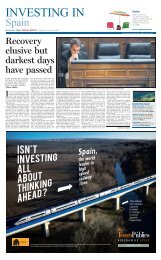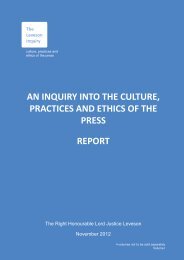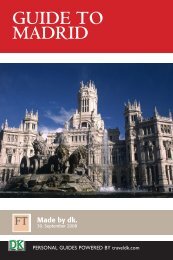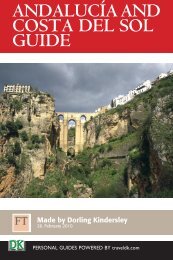CRETE TRAVEL GUIDE
CRETE TRAVEL GUIDE
CRETE TRAVEL GUIDE
Create successful ePaper yourself
Turn your PDF publications into a flip-book with our unique Google optimized e-Paper software.
Crete Travel Guide<br />
still undeciphered Phaestos Disc, which was discovered<br />
here, is on display in the Irakleio Archaeological Museum<br />
(see Irakleio Archaeological Museum). Phaestos was<br />
destroyed around 1450 BC by the cataclysm that also<br />
laid low the rest of Crete’s Minoan palaces. Not usually<br />
as crowded as the more famous Knosos, the site at<br />
Phaestos has an impressive location on a hillside above<br />
fertile farmland (see Phaestos).<br />
3 Gortys<br />
Toppled Roman<br />
columns, a ruined Byzantine<br />
basilica, post-Minoan<br />
fortifications, and an agora,<br />
acropolis and remains of<br />
temples to Athena and<br />
Apollo all hint at the past<br />
glories of this large and little-visited archaeological site<br />
close to Crete’s south coast. First settled in Minoan<br />
times, it became one of the most important cities of<br />
Doric Crete. It later allied itself with the Romans to<br />
become an important provincial capital, and was one of<br />
Crete’s most prosperous cities until it was sacked by<br />
Arab invaders during the anarchic years of the 8th century<br />
AD (see Gortys).<br />
4 Irakleio<br />
The modern capital of<br />
Crete was badly damaged in<br />
World War II, and few of its<br />
old Venetian buildings<br />
survived the reconstruction<br />
of the city. However, its<br />
Venetian fortress, harbour,<br />
arsenal and city walls are still impressive. For a morning’s<br />
itinerary see pages 82–3. The city’s main attraction is<br />
the Irakleio Archaeological Museum (see Irakleio).<br />
Café, Irakleio market<br />
5<br />
Diktian Cave<br />
According to ancient Greek myths, this mossy<br />
cavern, filled with strange limestone formations, was<br />
the birthplace of the greatest Olympian god, Zeus. Rhea,<br />
Zeus’s mother, supposedly hid the young godling from<br />
his father, Kronos, here. Bronze figurines and Minoan<br />
double axes found in the cave are on show in the Irakleio<br />
Archaeological Museum. The site is also often referred<br />
to as the Idaian Cave.<br />
➤ Map L5<br />
6 Lasithi<br />
The so-called “Plain of<br />
Windmills” is a high plain of<br />
fertile farmland surrounded<br />
by bare grey limestone hills.<br />
Its nickname is misleading,<br />
though. Only a few rusting<br />
metal derricks remain of the<br />
famed white-sailed windmills that once dotted the<br />
plateau in their hundreds. However, Lasithi is still worth<br />
traveldk.com<br />
a visit for the spectacular drive through the mountains<br />
and the glimpses it offers of a traditional way of life.<br />
➤ Map M4<br />
Mt Idi<br />
At 2,456 m (8,055 ft),<br />
Mt Idi, which is also known<br />
as Mt Ida and Mt Psiloritis,<br />
is Crete’s highest mountain.<br />
Only fit, experienced and<br />
well-equipped mountain<br />
walkers should try the<br />
eighthour hike to its summit and back. However, it is<br />
possible to drive as far as the Nida Plateau, 1,400 m<br />
(4,600 ft) above sea level, from which there are<br />
spectacular views.<br />
➤ Map G–H4<br />
8<br />
Kazantzakis Museum<br />
Cretan author Nikos Kazantzakis (1883–1957) is best<br />
known outside Greece for the novel Alexis Zorbas , which<br />
is set in Crete during the early 20th century. The book<br />
was filmed in 1964 as Zorba the Greek , starring Anthony<br />
Quinn in the title role. Kazantzakis’ outspoken humanism<br />
led the Orthodox church to regard him as a heretic. The<br />
author was born in Mirtia, and a small museum in the<br />
village (in the Kazantzakis family home) is crammed with<br />
his manuscripts and diaries, film posters, photos and<br />
other memorabilia.<br />
➤ Map K4 • Mirtia village square, signposted •<br />
9am–1pm, 4–8pm; Closed Thu • Adm<br />
9<br />
Agia Triada<br />
Excavated by Italian archaeologists at the beginning<br />
of the 20th century, Agia Triada is smaller than other<br />
Minoan sites such as Knosos and Phaestos and was<br />
probably an aristocratic villa or a royal summer palace.<br />
Some of the finest Minoan pottery, including three carved<br />
stone vases, was discovered here and is displayed in the<br />
Irakleio Archaeological Museum. Agia Triada is only 3<br />
km (2 miles) west of Phaestos, so can easily be visited<br />
on the same day. Because Agia Triada receives fewer<br />
vistors than the larger sites, you can explore its<br />
honeycomb of stone corridors, stairs and courtyards at<br />
your own pace.<br />
7<br />
➤ Map G5 • 8:30am–3pm • Adm<br />
10<br />
Boutari Winery and Audio-Visual Show<br />
At the Fantaxometochi Winery, south of Knosos<br />
near Archanes village, one of Greece’s leading<br />
winemakers has opened Crete’s newest purpose-built<br />
visitor attraction. A state-of-the-art audio-visual show<br />
celebrates the island – its landscapes, history and<br />
traditional way of life. The show also highlights the<br />
vineyards and grape varieties that produce some of the<br />
Boutari family’s award-winning wines. You can sample<br />
and buy Boutari red and white wines at the winery shop.<br />
➤ Map K4 • 9am–6pm Mon–Sat; Closed Nov–Mar •<br />
Adm<br />
55<br />
Things to See
















